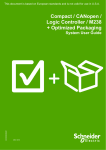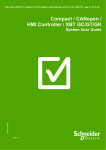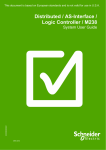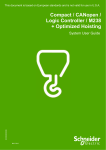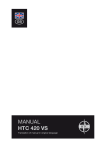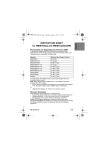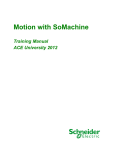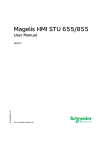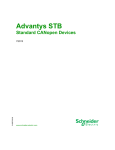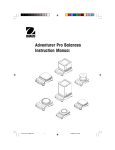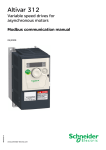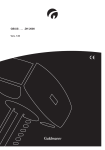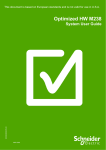Download Optimized HW M238 (System User Guide for
Transcript
This document is based on European standards and is not valid for use in U.S.A. Compact / Hardwired / Logic Controller / M238 EIO0000000290.01 System User Guide FEB 2011 Contents Important Information ................................................................................................................3 Before You Begin..................................................................................................................4 Introduction ................................................................................................................................6 Abbreviations........................................................................................................................7 Glossary ................................................................................................................................8 Application Source Code .....................................................................................................9 Typical Applications...........................................................................................................10 System ......................................................................................................................................12 Architecture ........................................................................................................................12 Installation...........................................................................................................................15 Hardware ..........................................................................................................................................................19 Software ...........................................................................................................................................................38 Communication ...............................................................................................................................................39 Implementation ...................................................................................................................41 Communication ...............................................................................................................................................43 Controller .........................................................................................................................................................44 HMI....................................................................................................................................................................75 Devices.............................................................................................................................................................84 Altivar 12 ..................................................................................................................................................... 85 Altivar 312 ................................................................................................................................................... 88 Lexium 32C ................................................................................................................................................. 92 Wireless pushbutton.................................................................................................................................. 98 Appendix.................................................................................................................................103 Detailed Component List .................................................................................................103 Component Protection Classes.......................................................................................106 Environmental Characteristics ........................................................................................106 Component Features........................................................................................................107 Contact....................................................................................................................................111 Optimized HW M238 Schneider Electric 2 Important Information NOTICE Read these instructions carefully, and look at the equipment to become familiar with the device before trying to install, operate, or maintain it. The following special messages may appear throughout this documentation or on the equipment to warn of potential hazards or to call attention to information that clarifies or simplifies a procedure. The addition of this symbol to a Danger or Warning safety label indicates that an electrical hazard exists, which will result in personal injury if the instructions are not followed. This is the safety alert symbol. It is used to alert you to potential personal injury hazards. Obey all safety messages that follow this symbol to avoid possible injury or death. DANGER DANGER indicates an imminently hazardous situation which, if not avoided, will result in death or serious injury. WARNING WARNING indicates a potentially hazardous situation which, if not avoided, can result in death or serious injury. CAUTION CAUTION indicates a potentially hazardous situation which, if not avoided, can result in minor or moderate injury. CAUTION CAUTION, used without the safety alert symbol, indicates a potentially hazardous situation which, if not avoided, can result in equipment damage. PLEASE Electrical equipment should be installed, operated, serviced, and maintained only by qualified personnel. No responsibility is assumed by Schneider Electric for any NOTE consequences arising out of the use of this material. A qualified person is one who has skills and knowledge related to the construction and operation of electrical equipment and the installation, and has received safety training to recognize and avoid the hazards involved © 2008 Schneider Electric. All Rights Reserved. Optimized HW M238 Schneider Electric 3 Before You Begin Do not use this product on machinery lacking effective point-of-operation guarding. Lack of effective point-ofoperation guarding on a machine can result in serious injury to the operator of that machine. WARNING UNGUARDED MACHINERY CAN CAUSE SERIOUS INJURY • Do not use this software and related automation products on equipment which does not have point-of-operation protection. • Do not reach into machine during operation. Failure to follow these instructions can cause death, serious injury or equipment damage. This automation equipment and related software is used to control a variety of industrial processes. The type or model of automation equipment suitable for each application will vary depending on factors such as the control function required, degree of protection required, production methods, unusual conditions, government regulations, etc. In some applications, more than one processor may be required, as when backup redundancy is needed. Only the user can be aware of all the conditions and factors present during setup, operation and maintenance of the machine; therefore, only the user can determine the automation equipment and the related safeties and interlocks which can be properly used. When selecting automation and control equipment and related software for a particular application, the user should refer to the applicable local and national standards and regulations. A “National Safety Council’s” Accident Prevention Manual also provides much useful information. In some applications, such as packaging machinery, additional operator protection such as point-of-operation guarding must be provided. This is necessary if the operator’s hands and other parts of the body are free to enter the pinch points or other hazardous areas and serious injury can occur. Software products by itself cannot protect an operator from injury. For this reason the software cannot be substituted for or take the place of point-ofoperation protection. Ensure that appropriate safeties and mechanical/electrical interlocks for point-of-operation protection have been installed and are operational before placing the equipment into service. All mechanical/electrical interlocks and safeties for point-of-operation protection must be coordinated with the related automation equipment and software programming. NOTE: Coordination of safeties and mechanical/electrical interlocks for point-of-operation protection is outside the scope of this document. START UP AND TEST Before using electrical control and automation equipment for regular operation after installation, the system should be given a start up test by qualified personnel to verify correct operation of the equipment. It is important that arrangements for such a check be made and that enough time is allowed to perform complete and satisfactory testing. Optimized HW M238 Schneider Electric 4 CAUTION EQUIPMENT OPERATION HAZARD • Verify that all installation and set up procedures have been completed. • Before operational tests are performed, remove all blocks or other temporary holding means used for shipment from all component devices. • Remove tools, meters and debris from equipment. Failure to follow these instructions can result in injury or equipment damage. Follow all start up tests recommended in the equipment documentation. Store all equipment documentation for future reference. Software testing must be done in both simulated and real environments. Verify that the completed system is free from all short circuits and grounds, except those grounds installed according to local regulations (according to the National Electrical Code in the U.S.A, for instance). If high-potential voltage testing is necessary, follow recommendations in equipment documentation to prevent accidental equipment damage. Before energizing equipment: • Remove tools, meters, and debris from equipment. • Close the equipment enclosure door. • Remove ground from incoming power lines. • Perform all start-up tests recommended by the manufacturer. OPERATION AND ADJUSTMENTS The following precautions are from NEMA Standards Publication ICS 7.1-1995 (English version prevails): • Regardless of the care exercised in the design and manufacture of equipment or in the selection and rating of components, there are hazards that can be encountered if such equipment is improperly operated. • It is sometimes possible to misadjust the equipment and thus produce unsatisfactory or unsafe operation. Always use the manufacturer’s instructions as a guide for functional adjustments. Personnel who have access to these adjustments should be familiar with the equipment manufacturer’s instructions and the machinery used with the electrical equipment. • Only those operational adjustments actually required by the operator should be accessible to the operator. Access to other controls should be restricted to prevent unauthorized changes in operating characteristics. WARNING UNINTENDED EQUIPMENT OPERATION • Only use software tools approved by Schneider Electric for use with this equipment. • Update your application program every time you change the physical hardware configuration. Failure to follow these instructions can cause death, serious injury or equipment damage. Optimized HW M238 Schneider Electric 5 Introduction Introduction This document is intended to provide a quick introduction to the described system. It is not intended to replace any specific product documentation, nor any of your own design documentation. On the contrary, it offers additional information to the product documentation, for installing, configuring and implementing the system. The architecture described in this document is not a specific product in the normal commercial sense. It describes an example of how Schneider Electric and third-party components may be integrated to fulfill an industrial application. A detailed functional description or the specification for a specific user application is not part of this document. Nevertheless, the document outlines some typical applications where the system might be implemented. The architecture described in this document has been fully tested in our laboratories using all the specific references you will find in the component list near the end of this document. Of course, your specific application requirements may be different and will require additional and/or different components. In this case, you will have to adapt the information provided in this document to your particular needs. To do so, you will need to consult the specific product documentation of the components that you are substituting in this architecture. Pay particular attention in conforming to any safety information, different electrical requirements and normative standards that would apply to your adaptation. It should be noted that there are some major components in the architecture described in this document that cannot be substituted without completely invalidating the architecture, descriptions, instructions, wiring diagrams and compatibility between the various software and hardware components specified herein. You must be aware of the consequences of component substitution in the architecture described in this document as substitutions may impair the compatibility and interoperability of software and hardware. Optimized HW M238 Schneider Electric 6 Abbreviations Abbreviation AC CB CFC DI DO DC DFB E-STOP FBD HMI I/O IL LD PC POU PS RMS RPM SE SFC ST TVDA VSD WxHxD Optimized HW M238 Signification Alternating Current Circuit Breaker Continuous Function Chart - a programming language based on function chart Digital Input Digital Output Direct Current Derived Function Blocks Emergency Stop Function Block Diagram - an IEC-61131 programming language Human Machine Interface Input/Output Instruction List - a textual IEC-61131 programming language Ladder Diagram - a graphic IEC-61131 programming language Personal Computer Programmable Object Unit, Program Section in SoMachine Power Supply Root Mean Square Revolution Per Minute Schneider Electric Sequential Function Chart - an IEC-61131 programming language Structured Text - an IEC-61131 programming language Tested, Validated and Documented Architecture Variable Speed Drive Dimensions: Width, Height and Depth Schneider Electric 7 Glossary Expression Altivar (ATV) Harmony Lexium (LXM) Magelis Modicon M238 Logic controller Modbus OsiSense Phaseo Preventa SoMachine TeSys Vijeo Designer Optimized HW M238 Signification SE product name for a family of VSDs SE product name for a family of switches and indicators SE product name for a family of servo drives SE product name for a family of HMI devices SE product name for Logic Controller A Communications protocol SE product name for a family of sensors SE product name for a family of power supplies SE product name for a family of safety devices SE product name for an integrated software tool SE product name for a family for motor protection devices and load contactors SE product name for Magelis HMI devices configuration software Schneider Electric 8 Application Source Code Introduction The example source code is in the form of configuration, application and import files. Use the appropriate software tool to either open or import the files. Extension CSV DWG DOC PDF PROJECT RTF VDZ ZW1 Optimized HW M238 File Type Comma Separated Values, Spreadsheet Project file Document file Portable Document Format - document Project file Rich Text File - document Project file Project archive file Schneider Electric Software Tool Required MS Excel AutoCAD Microsoft Word Adobe Acrobat SoMachine Microsoft Word Vijeo Designer EPLAN P8 9 Typical Applications Introduction Here you will find a list of the typical applications and their market segments, where this system or subsystem can be applied: Textile • Opening and closing machines • Circular knitting machines • Plucking machines • Blending machine • Carding machines • Drawing frame machines • Combing machines • Ring Spinning machines Other Machines • Wood working machines • Cutting machines • Sanding machines • Sawing machines Optimized HW M238 Schneider Electric 10 SPECIAL NOTE The products specified in this document have been tested under actual service conditions. Of course, your specific application requirements may be different from those assumed for this and any related examples described herein. In that case, you will have to adapt the information provided in this and other related documents to your particular needs. To do so, you will need to consult the specific product documentation of the hardware and/or software components that you may add or substitute for any examples specified in this documentation. Pay particular attention and conform to any safety information, different electrical requirements and normative standards that would apply to your adaptation. The application examples and descriptions contained in this document have been developed based on products and standards available and defined for Europe. Some or all of the application examples may contain recommendations of products that are not available in your country or locality, or may recommend wiring, products, procedures or functions that are in conflict with your local, regional or national electrical or safety codes and/or normative standards. NOTE: The information in this document is based on European standards and may not be valid for use in the U.S.A. The use and application of the information contained herein require expertise in the design and programming of automated control systems. Only the user or integrator can be aware of all the conditions and factors present during installation and setup, operation, and maintenance of the machine or process, and can therefore determine the automation and associated equipment and the related safety provisions and interlocks which can be effectively and properly used. When selecting automation and control equipment, and any other related equipment or software, for a particular application, the user or integrator must also consider any applicable local, regional or national standards and/or regulations. Optimized HW M238 Schneider Electric 11 System Introduction The system chapter describes the architecture, the dimensions, the quantities and different types of components used within this system. Architecture General The controller in this application is a Modicon M238 Logic controller. The user can control and monitor the application using the Magelis HMI device. The motor drives, which are hardwired to the controller, are of the type Altivar 12, Altivar 312 and servo drive Lexium 32C. The example application includes two functional safety options according to EN ISO 13849-1 standards: an Emergency Stop function supervised by a Preventa Safety Module (see the appropriate hardware manual), plus a second Preventa Safety Module to evaluate protective door sensors. Layout Optimized HW M238 Schneider Electric 12 Components Hardware: • Compact NSX100F main switch • Phaseo ABL8 power supply 230 Vac / 24 Vdc • Modicon M238 Logic controller • Magelis HMISTU655 • Motor circuit breaker GV2L (short circuit protected) • TeSysD load contactors LC1D • Altivar 12 and Altivar 312 variable speed drives • Lexium 32C servo drive • BMH servo motor • Multi9 circuit breaker • Emergency Stop switch with rotation release XALK • Harmony illuminated pushbuttons XB5 • Harmony receiver ZBR RA • Harmony wireless push button ZB5 RTA • OsiSense limit switches • Preventa guard switch • Preventa safety module Software: • Quantities of Components SoMachine V3.0 For a complete and detailed list of components, the quantities required and the order numbers, please refer to the components list at the end of this document. Degree of Protection Not all the components in this configuration are designed to withstand the same environmental conditions. Some components may need additional protection, in the form of housings, depending on the environment in which you intend to use them. For environmental details of the individual components please refer to the list in the appendix of this document and the appropriate user manual. Cabinet Technical Data Input Mains voltage Power requirement Cable Size Cable Connection 400 Vac ~ 3 kW 5 x 2.5 mm² (L1, L2, L3, N, PE) 3 phase + Neutral + Ground Neutral is needed for 230 Vac (Phase and Neutral) Output Motor power ratings 1 asynchronous motor (4 poles:1500 RPM) controlled by ATV12 (0.37 kW) 1 asynchronous motor controlled by ATV312 (0.37 kW) 1 servo motor (BMH type without brake) controlled by LXM32C (continuous output current : 6 A RMS at 6000 RPM) Optimized HW M238 Schneider Electric 13 Functional Safety Notice (EN ISO 13849-1 EN IEC 62061) The standard and level of functional safety you apply to your application is determined by your system design and the overall extent to which your system may be a hazard to people and machinery. Whether or not a specific functional safety category should be applied to your system should be ascertained with a proper risk analysis. This document is not comprehensive for any systems using the given architecture and does not absolve users of their duty to uphold the functional safety requirements with respect to the equipment used in their systems or of compliance with either national or international safety laws and regulations Emergency Stop Emergency Stop/Emergency Disconnection function Safety Function Door guarding Dimensions The dimensions of the individual devices used; controller, drive, power supply, etc. require a housing cabinet size of at least 1200 x 800 x 400 mm (WxHxD). This function for stopping in an emergency is a protective measure which compliments the safety functions for the safeguarding of hazardous zones according to prEN ISO 12100-2. up to Performance Level (PL) = b, Safety Integrity Level (SIL) = 1 The HMI display, illuminated indicators such as “SYSTEM ON“, “SYSTEM OFF“ or “ACKNOWLEDGE EMERGENCY STOP“ as well as the Emergency Stop switch itself, can be built into the door of the cabinet. Optimized HW M238 Schneider Electric 14 Installation Introduction This chapter describes the steps necessary to set up the hardware and configure the software required to fulfill the described function of the application. Assembly Main cabinet front Optimized HW M238 Schneider Electric 15 Main cabinet interior Optimized HW M238 Schneider Electric 16 Field devices and motors Optimized HW M238 Schneider Electric 17 Notes The components designed for installation in a cabinet, i.e. the controller, safety module, circuit breakers, contactors, motor circuit breakers, power supply and TM2 I/O modules can be mounted on a 35 mm DIN rail. Main switch, Lexium 32 servo drives and Altivar 12, Altivar 312 variable speed drives are screwed directly onto the mounting plate. The Emergency Stop button, door guard switches and the pushbutton housing for the display and acknowledgement indicators are designed for on-wall mounting in the field. All switches (except the door guard switch) can also be installed directly inside a control cabinet (e.g., in a cabinet door) without special housings. There are two options for installing XB5 pushbuttons or indicator lamps: These pushbuttons or switches can be installed either in a 22 mm hole, e.g., drilled into the front door of the control cabinet, or in an XALD-type housing suitable for up to 5 pushbuttons or indicator lamps. The XALD pushbutton housing is designed for backplane assembly or direct wall mounting. The architecture includes a Harmony wireless push button ZB5 RTA and a Harmony receiver ZBR RA to switch a tower light. The individual components must be interconnected in accordance with the detailed circuit diagram in order to ensure that they function correctly. • 400 Vac 3-phase wiring between the main circuit breaker, the Altivar 312 drive and the motor. • 230 Vac 1-phase wiring between the main circuit breaker and Altivar 12 drive and 3-phase wiring between the Altivar 12 drive and the motor. • 230 Vac 1-phase wiring between the main circuit breaker and Lexium 32C drive. • 230 Vac 1-phase wiring between the main circuit breaker and primary side of the 24 Vdc power supply. • 24 Vdc wiring for control circuits and the controller, I/O modules and the HMI. Serial Line VW3A8306R30 cable is installed for the communication link between the controller and the HMI. The modules and I/O listed here are a representative cross section of the modules and indicators required to implement the application as defined in this document and will without doubt differ from your own specific application. Optimized HW M238 Schneider Electric 18 Hardware General General description of the hardware, assembly instructions. Main switch Compact NSX100F LV429003 36 kA 380/415 Vac Main Switch Compact NSX100F LV429037 Trip unit TM16D Thermal-magnetic 16 A Ir - Thermal protection Im - Magnetic protection Main Switch Compact NSX100F Rotary handle LV429340 Terminal shield LV429515 Rotary handle with red handle on yellow front Terminal shield short Emergency Stop switch Harmony XB5AS844 + XB5AZ141 Optimized HW M238 Schneider Electric 19 Push Button Harmony with indicator lamp XB5 Wireless pushbutton transmitter Harmony ZBRM01 Programmable Receiver for wireless pushbutton Harmony ZBRRA Power Supply Phaseo ABL8RPS24050 Primary 200…500 Vac, Secondary 24 Vdc, 120 W, 5 A Optimized HW M238 Schneider Electric 20 Controller Modicon M238 Logic controller TM238LDD24DT 14 Digital Inputs incl. 8 Fast Inputs, 10 Digital Outputs incl. 4 Fast Outputs, (1) Sink inputs (positive logic) (2) Source inputs (negative logic) Optimized HW M238 Schneider Electric 21 Controller Modicon M238 Logic controller TM238LDD24DT 1. The controller and integrated communication port status by means of 5 LEDs (PWR, RUN, Batt, Err and SL1). 2 . A display unit showing the Input states (I0…I13). 3. A display unit showing the Output states (Q0…Q9). 4. RJ 45 connector for connection of a serial link marked SL1 (SoMachine protocol). 5. A removable screw terminal block (12 terminals) for connecting the sensors (24 Vdc fast inputs). 6. A removable screw terminal block (6 terminals) for connecting the 4 pre-actuators (24 Vdc fast outputs). 7. A removable screw terminal block (10 terminals) for connecting the 6 pre-actuators (24 V dc outputs). 8. A removable screw terminal block (7 terminals) for connecting the sensors (24 Vdc inputs). 9. A connector for extension modules, for example TWDNOI10M3 (7 modules max.). 10. Mini B USB Port, for a programming terminal. 11. A non-removable screw terminal block (3 terminals +, -, t marked 24 Vdc) for connecting the 24 Vdc power supply. With access from the underside of the controller: 12. A hinged cover for accessing the optional backup battery for the RAM memory and the real-time clock inside the base. Optimized HW M238 Schneider Electric 22 TM2 I/O Module TM2DDI16DT 16 Digital Inputs, 24 Vdc Sink/Source, Removable Screw Terminal Block (a) Source inputs (b) Sink inputs TM2 I/O Module TM2DMM24DRF 16 Inputs, 24 Vdc 8 Relays Outputs, 24 Vdc Non-removable spring Terminal Block Optimized HW M238 Schneider Electric 23 TM2 I/O Module TM2AMM6HT 4 Analog Inputs (0…10 Vdc / 4…20 mA) 2 Analog Outputs (0..10 Vdc / 4..20 mA) Volt/Current Configuration TM2 I/O Module TM2AMI4LT 4 Analog Inputs (0… 10 Vdc / 4… 20 mA) alternatively 4 Temperature Probes (Pt100 / Pt1000 / Ni100 / Ni1000) Optimized HW M238 Temperature Probe Configuration Schneider Electric 24 HMI Magelis HMISTU655 24 Vdc Input, 3.5” colour TFT, 320 x 240 Pixels, 65536 Colors, 16 MB Application Flash EPROM with Built-in Ethernet 1 A removable screw terminal block for the 24 V c power supply 2 An RJ45 connector for RS 232C or RS 485 serial link connection to PLCs (COM1) 3 A USB type A host connector for: • Connection of a peripheral device • Connection of a USB memory stick • Application transfer 4 A USB mini-B device connector for application transfer (on the left-hand side) 5 An RJ45 connector for the Ethernet TCP/IP 10BA SE-T/100BA SE-TX link Motor Circuit Breaker TeSys GV2L07 and GV2L14 Used together with auxiliary contact GVAE11 Optimized HW M238 Schneider Electric 25 Circuit Breaker Multi 9 23726, 23747, 24518 and 26135 Contactor TeSysD LC1D09BD Optimized HW M238 Schneider Electric 26 Variable Speed Drive Altivar 12 ATV12H037M2 1-phase External 0…10 Vdc Analog Signal as Speed Reference 230 Vac, 0.37 kW 1. 2. 3. 4. 5. R1 relay contacts, for remote indication of the drive status. Internal + 24 V c. If an external source is used (+ 30 V c maximum), connect the 0 V of the source to the COM terminal, and do not use the + 24 V c terminal on the drive. Reference potentiometer SZ1RV1202 (2.2 kΩ) or similar (maximum 10 kΩ). Optional braking module VW3A7005 Optional braking resistor VW3A7ppp or other acceptable resistor. • Variable Speed Drive Altivar 312 ATV312H037N4 3-phase External 0…10 Vdc Analog Signal as Speed Reference 400 Vac, 0.37 kW Optimized HW M238 Schneider Electric 27 Variable Speed Drive Altivar 312 ATV312H037N4 1. Line choke, if used 2. Detected fault relay contacts, for remote indication of the drive status 3. Braking resistor, if used Variable Speed Drive Altivar 312 ATV312H037N4 Terminal connection The following is mandatory to ensure that the logic inputs can be energized using M238 transistor outputs: Toggle the logic input configuration switch to CLI position Connect the CLI terminal to the 0 Vdc reference potential Optimized HW M238 Schneider Electric 28 Servo Drive Lexium 32C LXM32CD18M2 1-phase 230 Vac, Continuous output current: 6 A RMS at 6000 RPM Servo Drive Lexium 32C LXM32CD18M2 Embedded Human Machine Interface Optimized HW M238 Schneider Electric 29 Servo Drive Lexium 32C LXM32CD18M2 Control Panel Overview of the Signal Connectors Servo Drive Lexium 32C LXM32CD18M2 Power Connection CN1 Optimized HW M238 Schneider Electric 30 Servo Drive Lexium 32C LXM32CD18M2 Connection to the controller supply Voltage and STO CN2 The controller supply voltage (24 Vdc) must be connected for all operating modes Optimized HW M238 Schneider Electric 31 Servo Drive Lexium 32C LXM32CD18M2 Signal Connector CN3 A: Encoder Cable Connection to Motor (Length 3 m) VW3M8101R30 Servo Drive Lexium 32C LXM32CD18M2 Signal Connector CN5 (PTO-Channel) Optimized HW M238 Schneider Electric 32 Servo Drive Lexium 32C LXM32CD18M2 Wiring diagram, digital inputs/outputs CN6 Optimized HW M238 Schneider Electric 33 Servo Drive Lexium 32C LXM32CD18M2 Connecting the external braking resistor CN8 Servo Drive Lexium 32C LXM32CD18M2 Parallel connection of DC bus. CN9 Optimized HW M238 Schneider Electric 34 Servo Drive Lexium 32C LXM32CD18M2 Motor Connection CN10 Power Cable Connection to Motor (Length 3 m) VW3M5101R30 Servo Drive Lexium 32C LXM32CD18M2 Wiring diagram holding brake CN11 Servo Motor BMH0702T06A2A Connected to Motor Terminals and CN3 of LXM32 using the cables VW3M5101R30 and VW3M8101R30 respectively. Optimized HW M238 Schneider Electric 35 Safety Module Preventa XPSAC5121 Guard Switch Preventa XCSPA792 Limit Switch OsiSense XCKP2118P16 Optimized HW M238 Schneider Electric 36 Tower Light Harmony XVBC21 CONNECTION ELEMENT XVBC33 SIGNAL ELEMENT GREEN XVBC34 SIGNAL ELEMENT RED XVBC36 SIGNAL ELEMENT BLUE XVBC37 SIGNAL ELEMENT CLAER XVPC34 RED LENS XVPC36 BLUE LENS XVPC37 CLAER LENS Optimized HW M238 Schneider Electric 37 Software General The main programming work lies in programming the Modicon M238 Logic controller and creating the screens for the HMI display. Programming the Modicon M238 Logic controller is done using SoMachine. Programming of the Magelis HMISTU655 is done by using Vijeo Designer which is integrated into SoMachine. Configuration of the drives (ATV12, ATV312 and LXM32C) is done using the control panel on the drive. To use the software packages, your PC must have the appropriate Microsoft Windows operating system installed: • Windows XP Professional The software tools have the following default install paths: SoMachine C:\Program Files\Schneider Electric\SoMachine Vijeo Designer (Installed with SoMachine) C:\Program Files\Schneider Electric\Vijeo Designer Optimized HW M238 Schneider Electric 38 Communication General The Modicon M238 Logic controller and the Magelis HMI STU655 communicate using the SoMachine protocol. The download from the PC to the M238 and to the HMI is done using a single connection. The PC has to be connected to the HMI over USB. Using this connection the data is also send across to the M238. The front panel is used to configure the ATV12, the ATV312 and the LXM32C. PC ↔ HMISTU655 ↔ M238 The download direction is from the PC to the HMI and via the HMI to the M238. Note: For a direct connection to the M238 the TCSXCNAMUM3P cable should be used Optimized HW M238 1. 2. 3. 4. 5. PC HMI STU655 Modicon M238 Logic controller USB to USB cable XBTZG935 RJ45 (HMI) to RJ45 (M238) cable VW3A8306R30 Schneider Electric 39 PC ↔ HMI connection cable XBTZG935 Cable for the connection between a SoMachineequipped PC and HMISTU655 Controller ↔ HMI connection cable VW3A8306R30 (3m) Cable for connecting an HMISTU655 and an M238 Optimized HW M238 Schneider Electric 40 Implementation Introduction The implementation chapter describes all the steps necessary to initialize, to configure, to program and start-up the system to achieve the application functions as listed below. Function Start up and functional description 1. Verify all motor circuit breakers and Multi9 circuit breakers are in the ON position. 2. Verify that the main switch is in the ON position. 3. Press the "ACKN E-STOP" blue illuminated pushbutton on the main cabinet door to acknowledge the system is energized. The blue illuminated pushbutton will turn OFF if the system is energized. 4. Ensure that all machine interlocks are engaged (i.e. the door guard switches) 5. Press the "ACKN DOOR-READY" blue illuminated pushbutton on the main cabinet door to acknowledge the system is ready for operation. The blue illuminated pushbutton will turn OFF if the system is ready for operation. 6. Use Magelis HMISTU655 to control/monitor the system. a. Manual Mode: Using the screens ATV12, ATV312 and LXM32C you can control the drives individually by touching the buttons FWD, REV, STOP and RESET. You can also individually adjust their manual speeds here. b. Local Mode: Control the drives from the selector switch located outside the cabinet. Reset drive faults by acknowledging the red illuminated push button. Use the screens ATV12, ATV312 and LXM32C, individually adjust their automatic speeds here. c. Use the HMISTU655 screen to configure the HMI. d. The “BUS”, “ALARM”, “SAFETY” screens can be used to monitor the network, system status and alarm messages. Functional Layout Optimized HW M238 Schneider Electric 41 Course of Action Optimized HW M238 Schneider Electric 42 Communication Introduction This chapter describes the data passed via the communication networks (e.g. CANopen or Ethernet) that is not bound directly with digital or analog hardware. Device Links The SoMachine protocol over serial port (RS485) connects: Magelis HMISTU655 ↔ Modicon M238 Logic controller The SoMachine protocol is used for the data exchange between the controller and the HMI. Optimized HW M238 Schneider Electric 43 Controller Introduction The controller chapter describes the steps required for the initialization and configuration and the source program required to fulfill the functions. Preconditions In order to proceed you require the following: • • • • SoMachine V3.0 is installed on your PC The Modicon M238 Logic controller is switched on and running The controller is connected to the HMI with the connection cable VW3A8306R30 (controller to HMI) The HMI is connected to the PC via the programming cable XBTZG935(HMI to PC) Setting up the controller is done as follows: • • • • • • • • • • • • • • • • • • Optimized HW M238 Create a New project Add the Controller Add IO Expansion Modules Configure PTO Function for LXM32 Add TeSys Library Add POU Add Symbol configuration Configure Task Configure Controller ↔ HMI Data Exchange Add Magelis HMI Add symbol configurations Communication Settings controller ↔ PC Communication Settings controller ↔ HMI Save the Project Build Application Download the Controller and HMI program Login to the Controller Application overview Schneider Electric 44 Create a new project 1 To create a new project select Create new machine. 2 Select Start with empty project. 3 In the Save Project As dialog enter a File name and press Save. Note: By default the project is saved under My Documents. Optimized HW M238 Schneider Electric 45 Add the Controller 4 The SoMachine User Interface opens and the Properties tab is displayed. 5 In the User Interface select the Program tab 6 The Program windows appears 1 Right click on Optimized_HW_M238. Select Add Device… in the pop up menu. Optimized HW M238 Schneider Electric 46 2 Select Schneider Electric as Vendor. Then select: Logic Controller → M238 → TM238LDD24DT as a controller. Click on Add Device. Click on Close. Add IO Expansion Modules 3 The Devices folder display now the new Controller 1 To add expansion modules to the controller, right click on MyController and click on Add Device…. Optimized HW M238 Schneider Electric 47 2 In the Add Device dialog, select the required I/O expansion modules and click on Add Device. For this project, the following modules are used: 1x TM2DDI16DT 1x TM2DMM24DRF 1x TM2AMM6HT 1x TM2AMI4LT When you have finished adding the modules, click on Close. 3 4 The added expansion modules can now be seen at the end of the device list. Note: The sequence of the modules have to be consistent with the sequence of the actual hardware, i.e. in this application, the TM2DDI16DT module is attached next to the controller whereas the TM2AMI4LT is attached furthest away from the controller. To configure an expansion module, double click on it. Here we will configure the analog output of the expansion module TM2AMM6HT. Optimized HW M238 Schneider Electric 48 5 In the I/O Configuration tab… 6 …the Value of the Enumeration of BYTE for the Type of QW0 is changed to 0..10 V. Press enter to accept the new selection. The Value of the Enumeration of BYTE for the Scope of QW0 can be selected between Normal (fixed min and max values) and Customized. Optimized HW M238 Schneider Electric 49 7 On the Extension Bus I/O Mapping tab it is possible to map the data of QW0 to a variable. There are two ways of Mapping: Create a new variable Mapping to an existing variable In this project, Map to existing variable was used, i.e. the output is mapped to an existing variable that is located in the folder Application → GVL. GVL stands for global variables list, which can be accessed throughout Application. The GVL is opened by double clicking on GVL in the Devices window. 8 In this application, q_wAtv12SpdRef is declared as a WORD variable in the Application’s GVL (Application.GVL.q_wAtv12 SpdRef). To map the output to an existing variable, double click on the output Variable field then click on the … button that appears at the end of the field. In the Input Assistant dialog that opens, locate the variable inside the Global Variables category and select it. Then click OK. Optimized HW M238 Schneider Electric 50 9 The analog module’s output WORD, QW0, will now map itself to Application.GVL.q_wAtv12 SpdRef. To update the status of all the I/O variables in every cycle with the newest I/O data, check the Always update variables box. If left unchecked, only the status of the I/O variables that are called in the POUs are updated. Note: The statuses of the mapped I/O variables that are used in the HMI but are not called by any POU are not updated if the Always update variables box is unchecked. Configure PTO Function for LXM32C 1 To configure the PTO function, double click on Embedded Functions → PTO_PWM in the Device list. 2 Optimized HW M238 In the PTO 0 tab… Schneider Electric 51 3 …the Value of the Enumeration of BYTE for the Mode of PTO00 is changed to PTO. 4 By default, the PTO 0 output of the M238 controller is mapped to a Variable called PTO00. In this application, the PTO 0 default settings are used. 5 6 The library that manages the PTO of the M238 controller is located inside the Library Manager. Double click on Library Manager in the Device window to open the Library Manager editor. The Library Manager editor has the following components: 1. Libraries currently included in the project 2. Modules (for example: FBs) of the currently selected library showed in the lower part of the Library Manager 3. Information of the module currently selected in the lower part of the Library Managed 7 Optimized HW M238 The library M238 PTOPWM is directly loaded into the project when a M238 controller is used in the application. Schneider Electric 52 8 When you select the M238 PTOPWM library from the list, the PTO modules are displayed in the lower left part of the editor. In the lower right part of the editor, the following tabs are displayed: Inputs/Outputs tab Graphical tab Documentation tab Optimized HW M238 Schneider Electric 53 9 More information on the M238 controller libraries and the PTO function can be found inside the Online Help. To open the Online Help window left click on Help → Contents Add TeSys Library 1 In this application, the function blocks MOT2D1S were used to manage the forward and reverse control of the ATV12, ATV312 and LXM32 drives. These function blocks are included inside the TeSys library. 2 Optimized HW M238 To add the TeSys library, click on Add library… in the Library Manager editor. Schneider Electric 54 3 In the Add library dialog, Placeholder tab, select: Placeholder name: SE_TeSys select: Devices → select: → TeSys Library And click on OK to insert the TeSys Library into the Library Manager. 4 Optimized HW M238 The new library can now be seen in the Library Manager editor list. Schneider Electric 55 Add POU 5 More information on the TeSys library, its modules and other Schneider Electric libraries can be found in the SoMachine Online Help under the Help menu by click on Contents. 6 Information on System libraries and their modules can be found in the Online Help under the folder CoDeSys -> Libraries 7 Steps 2 to 4 have to be executed when adding a new library. 1 To add a POU to the project, right click on Application and select → Add Object →POU… from the pop-up menu. Optimized HW M238 Schneider Electric 56 2 In the Add POU dialog that opens, enter a Name (here ATV_Control). Select Program as the Type and CFC as the Implementation language. It is possible to select all the IEC languages and to generate functions and function blocks. Click on Open to confirm and to close the dialog. 3 The new POU ATV_CONTROL is now visible under Application. If the ATV_CONTROL tab is not opened, double click on ATV_CONTROL to open it. 4 The upper frame displays the declaration section. The lower frame is for programming. On the right side is the ToolBox window. Use drag and drop with the toolbox to place example templates in the programming section. 5 Begin by placing a box element in the programming section. Then click on ???. Optimized HW M238 Schneider Electric 57 6 Type in a name for the function or function block. As the first letters are typed, a pop-up menu opens with a list of modules that begins with those letters. In this project, the MOT2D1S FB was used for controlling the forward and reverse commands of the drives. Select MOT2D1S from the list and press enter twice. 7 To instantiate the FB, click on ??? and… 8 … type in a name (for example ATV12_Ctrl) and press enter. The Auto Declare dialog opens. Click OK to create the instance. Note: The variable comment can be added in the Comment box. 9 Optimized HW M238 The new FB MOT2D1S is instantiated in the declaration section of the ATV_CONTROL. Schneider Electric 58 10 To connect a variable to an input, place an input element from the ToolBox on the input side of the FB and connect the input box to an FB input by clicking on the red end and dragging it to the input of the FB. Click on ??? in the input box and insert the variable name: i_xSelSwcLocFwd In the Auto Declare dialog that opens, select the Scope and Type and confirm the variable Name. In this example, select VAR_GLOBAL and BOOL from the Scope and Type list box respectively. 11 Connecting a variable to an output is done similarly as the input, but here, a new variable is created. Click on the ??? in the output field, type in a name for the variable and then press enter. In the Auto Declare dialog that opens, select the Scope and Type and confirm the variable Name. In this example, select VAR_GLOBAL and BOOL from the Scope and Type list box respectively. When finished, click on OK. Optimized HW M238 Schneider Electric 59 12 The VAR_GLOBAL variables are located in the GVL folder. All variables located in this folder can be accessed throughout Application. If the variables are declared inside the POU, they can only be accessed by the POU (local variables). Global Variables (Application Specific) Local Variables (POU Specific) Configure Task 1 The Task Configuration in the Devices window defines one or several tasks for controlling the processing of an application program. To start working with the new POU, it has to be added to a Task. Here, the POUs are added to MAST task. To do this, double click on MAST task. 2 Optimized HW M238 Note: If a POU is not included in a TASK, it will not be cyclically invoked. In the MAST tab, click on Add POU. Schneider Electric 60 3 In the Input Assistant dialog, select Programs from the Categories list and select the new POU from the Items list. In this application, the new POU is ATV_CONTROL. Click on OK to confirm. 4 Note: You have to add all POUs in the program! The POU is now included in the MAST task. In the upper left of the MAST task configuration, the Type of task can be modified. In this project, Freewheeling was selected. Close the tab when finished. Add Magelis HMI 1 To add a Magelis HMI unit to the project, right click on the project name and select Add Device… from the pop-up menu. In this project, it is Optimized_HW_M238 → Add Device... Optimized HW M238 Schneider Electric 61 2 In the Add Device dialog, select Schneider Electric as Vendor. Click on: Magelis HMI → HMISTU Series → HMISTU655 Click on Add Device and click on Close. 3 The new HMISTU655 is now listed under the project in the Device window. Note: When a Magelis HMI is added to a project, the programming software Vijeo Designer opens in a new window and you can start programming. (See HMI Chapter) Optimized HW M238 Schneider Electric 62 4 To change the name of the device, right click on the device (HMISTU655) in the project browser and select Properties… in the pop-up menu. Then enter the new name and click OK. Configure Controller ↔ HMI Data Exchange 1 Optimized HW M238 To link the variables between the controller and the HMI, the object Symbol configuration is used. To add a Symbol Configuration, right click on Application and select Add Object… → Symbol configuration Schneider Electric 63 2 A pop-up Add Symbol configuration opens. Click on Open. 3 In the opened Symbol configuration tab, click on Refresh. 4 Check the Messages window for the compilation result and correct any compilation errors. 5 Note: The Symbol configuration cannot be refreshed when there are errors in the program. All Variables created in the user program are shown in the Variables list. In this project, as all variables are global variables, they are located in the GVL folder. 6 Optimized HW M238 To link the variables from the controller to the HMI, select GVL and click on >. The right frame now lists the Selected variables which are to be used the HMI. Schneider Electric 64 7 Communication 1 Settings Controller ↔ PC 2 To export the selected variables to Vijeo Designer: Right click on Symbol configuration and select Export Symbols to VijeoDesigner. To configure the communication gateway, double click on MyController. On the Communication Settings tab click on: Add gateway... 3 Optimized HW M238 Keep the default settings and click on OK. Schneider Electric 65 4 Select Gateway-1 and click on Scan network. Note: Confirm that the controller is connected to the PC via the HMI. 5 During the scan, the Scan network button becomes grayed out. When the scan is finished, the Scan network button becomes active again and the devices that have been detected are listed under Gateway-1. Select the controller that is being used and click on Set active path. A hazard message pop-up window appears. Read the message and confirm. 6 Optimized HW M238 The controller is now bolded and marked (active). Schneider Electric 66 7 Note: Every M238 has a unique Serial Number that is a part of the default name (in this case: SN 782). If you would like to change the default name of your controller right click on (M238) SN 782 and select Change Device Name In the displayed pop-up window enter the new unique name for your controller. In our example we keep the factory setting name. Communication 1 Settings HMI ↔ PC 2 To configure the communication gateway double click on HMISTU655. Select Gateway-1 and click Scan network. Note: Confirm that the HMI is connected to the PC. Optimized HW M238 Schneider Electric 67 3 During the scan, the Scan network button becomes grayed out. When the scan is finished, the Scan network button becomes active again and the devices that have been detected are listed under Gateway-1. Select the HMI that is being used and click on Set active path. A hazards message pop-up window appears. Read the message and confirm. 4 Optimized HW M238 The HMI is now bolded and marked (active). Schneider Electric 68 Save the Project 1 To save the project, click File → Save Project To save the project under a different name, click 2 Build Application 1 File → Save Project As… In the Save Project dialog that opens after clicking on Save Project As…, enter the new File name and click on Save. To build the application, click on Build → Build 2 Note: To build the whole project (both HMI and Controller) click Build all. After the build, the Messages window will describe whether the build was successful or not. If the build was not successful there will be a compilation error list in the Messages window. Download the controller and HMI projects 1 Note: If it is the first time you are connecting to the HMI, you first have to download the latest runtime version to the HMI using Vijeo Designer. This first download is described in the following steps. If this is not the first download go directly to step 7. Optimized HW M238 Schneider Electric 69 2 In Vijeo Designer, select the target name (HMISTU655) in the Navigator to display the setting tabs. In the setting tab General select Download via USB. Note: The PC must be connected to the HMI via the cable XBTZG935. 3 Select: Build → Download All 4 Optimized HW M238 The VDPLoad dialog indicates that the runtime version does not match. Start the download of the new version via clicking on Yes. Schneider Electric 70 5 The actual state of the download is displayed in a progress bar. 6 Once the runtime download is complete, change the Download connection in the setting tab General back to SoMachine. 7 To download the application to the controller and the HMI change to the Online tab and select: Multiple Download… 8 Optimized HW M238 Check the controller (MyController) and the HMI (XBTGT2330), Always perform a full download and click on OK. Schneider Electric 71 9 Before the download starts, a build of the complete project is done. The result of the build is displayed in the Messages window. 10 The results of the download to the controller are displayed in the Multiple Download – Result window. Here are two examples: In the first dialog, there was downloaded. And in the second dialog, the application was created and downloaded. Click on Close to close to the results window. 11 Once the download to the controller is finished, the HMI download starts. 12 The result of the HMI download is displayed in the Messages window. Login to controller 1 Optimized HW M238 To login to the M238 click Online→ Login Schneider Electric 72 2 SoMachine will display a message according to the state of the M238 you are trying to login to. Here are two examples: In the first dialog, there is no program in the device. And in the second dialog, the controller program is different from the program on the PC. In both cases, you are asked to confirm whether to proceed with the download of the PC program into the controller. 3 4 If you do not wish to overwrite the controller program, skip to step 6, otherwise click Yes to confirm the download. The actual download status is displayed at the bottom left of the main window. To start running the Application in the controller, select Online → Start 5 Optimized HW M238 If everything is operating normally the devices and folders are marked in green otherwise they will be marked in red. Schneider Electric 73 Application overview 1 Optimized HW M238 The picture on the right shows the structure of the program. Schneider Electric 74 HMI Introduction This application uses a HMI device of type Magelis HMI STU655. The HMI communicates with the controller using SoMachine protocol over serial port (RS485). The Magelis is programmed using the software tool Vijeo Designer (Delivered with SoMachine) that is described briefly in the following pages. For the connection between the controller and the HMI, the cable XBTZG935 is used. Note: The Vijeo Designer Tool is opened via SoMachine. For more information see Controller chapter, Add Vijeo Designer HMI Setting up the HMI is done as follows: • • • • • • Main Window Settings –General, -Network Communication settings Create a Switch Create a Numeric Display Example Screens Open Vijeo Designer 1 To open the visualization tool Vijeo Designer, double click on HMI Application in the Device tab. Main Window 2 After creating a Vijeo Designer HMI program in SoMachine the target view Window of Vijeo Designer is displayed. Vijeo Designer has following components: 1. 2. 3. 4. 5. 6. Optimized HW M238 the Navigator InfoViewer Toolchest Property Inspector Feedback Zone Graphic List tab Schneider Electric 75 Settings 1 To open the settings double click on the device name (HMISTU655) in the Navigator. On the setting tabs (General, Network, Hardware, Options, Remote Access, Multimedia, Keys and Alarm) it is possible to change the basic settings for the visualization or to set parameters. Here the default setting are used: No change is necessary. Communication settings 1 To set the communication parameters select in the Navigator → IO Manager → SoMachineNetwork01 → double click on SOM_MyController 2 In the SoMachine – Network Equipment Config… dialog set the controller Equipment Address. You will find this address in SoMachine… Optimized HW M238 Schneider Electric 76 Create a Switch 3 … by double clicking the MyController in the SoMachine project browser. 4 ..In the Communication Settings Tab select the controller and select by using the right mouse key Change Device Name 5 ..The Equipment address or an alias for the controller is now displayed in the Change Device Name box 1 Click on the Switch icon in the toolbar. 2 Click on the panel where you wish to position the switch and then drag the cursor to size it. Then click again or press enter. Optimized HW M238 Schneider Electric 77 3 In the Switch Settings dialog, under the tab General, click on the bulb icon at the Destination field to select the variable that should be linked to the switch. 4 In the Variables List dialog that opens, select SoMachine and an imported variable (e.g. i_xSelSwcLocFwd) Click OK. Optimized HW M238 Schneider Electric 78 5 After the variable has been selected as the switch’s Destination, click on Add >. 6 In the Label tab, select Static as the Label Type and enter a name that the switch would be labeled with, e.g. FWD. If you wish, you can modify the label’s Font attributes (Style, Width, Height and Alignment). When you are satisfied with the switch settings, click on OK. 7 Optimized HW M238 The new switch in now on the Work frame. Schneider Electric 79 Create a Numeric Display 1 Click on the Numeric Display icon in the toolbar. 2 Click on the panel where you wish to position the numeric display and then drag the cursor to size it. Then click again or press enter. 3 In the Numeric Display Settings dialog, under the tab General, click on the bulb icon at the Variable field to select the variable that should be linked to the display. In Display Digits, the maximum number of digits to be displayed for the integral and fractional part of the value can be set. Optimized HW M238 Schneider Electric 80 Example Screens 4 The new numeric display is now on the Work frame. 1 The Home page of the HMI displays shows a picture of the complete architecture. 2 The System page has two functions: 1. To show the overall status for all devices and the temperature. 2. To select between LOCAL or MANUAL operation mode. 3 Optimized HW M238 The Alarm page shows the status of the system alarms and logs them chronologically. Schneider Electric 81 4 The “Safety” page shows the status of the emergency stop relay. 5 The ATV12 page is for setting the speed references of the ATV12 drive and controlling the drive when the system is operating in Manual mode. It also displays the status of the drive. 6 The ATV312 page is for setting the speed references of the ATV312 drive and controlling the drive when the system is operating in Manual mode. It also displays the status of the drive. 7 The LXM32 page is for setting the speed references of the LXM32 drive and controlling the drive in either speed or position mode when the system is operating in Manual mode. It also displays the status of the drive. Optimized HW M238 Schneider Electric 82 8 Optimized HW M238 The STU655 page allows to switch to the HMI system configuration menu. Schneider Electric 83 Devices Introduction This chapter describes the steps required to initialize and configure the different devices required to attain the described system function. General Altivar 12, Altivar 312 and Lexium 32C drives are configured by using the local control panel on the device itself. Note If this is not a new drive you should re-establish the factory settings. If you need instructions on how to do this, please read the drive documentation. Be sure that the controller is in STOP state before parameterizing the drives. Optimized HW M238 Schneider Electric 84 Altivar 12 Introduction The ATV12 parameters can be entered or modified via the local control panel on the front of the device itself. Note If this is not a new drive you should re-establish the factory settings. If you need instructions on how to do this, please read the drive documentation. The Jog dial that is a part of the local control panel can be used for navigation by turning it clockwise or counter-clockwise. Pressing the jog dial enables the user to make a selection or confirm information. Control panel 1 Optimized HW M238 The configuration of the Altivar can be done by using the buttons and the jog dial on the control panel of the Altivar. Schneider Electric 85 Inputs / Outputs configuration 1 To assign the inputs and outputs: Î Press MODE Î Select COnF and press enter Î Select FULL and press enter Î Select I_O- [INPUTS / OUTPUTS CFG] and press enter Î Select AII- and press enter Î Select AIIt (Analog input 1)and press enter Î Select 10U (0-10V) and press enter Î Return to AIIt with ESC Î Return to AII- with ESC Î Select r1 (relay output 1) and press enter Î Select FLt (No Fault) and press enter Î Return to r1 with ESC Î Select LO1- and press enter Î Select LO1 (Logic output 1) and press enter Î Select SrA (Speed reached) and press enter Î Return to LO1 with ESC Î Return to LO1- with ESC Î Return to I_O- with ESC Î Return to FULL with ESC Î Return to ConF with ESC Î Return to rdy with ESC Set Input for reverse function 1 To assign the input for the reverse function input: Î Î Î Î Î Î Î Î Î Î Î Optimized HW M238 Press MODE Select ConF and press enter Select FULL and press enter Select Fun- [APPLICATION FUNCT.] and press enter Select rrS (Reverse input) and press enter Select L2H (Logic input 2) and press enter Return to rrS with ESC Return to Fun- with ESC Return to FULL with ESC Return to ConF with ESC Return to rdy with ESC Schneider Electric 86 Fault management 1 To assign the settings for Fault management: Î Press MODE Î Select ConF and press enter Î Select FULL and press enter Î Select FLt- [FAULTMANAGEMENT] and press enter Î Select rSF (Reset Fault) and press enter Î Select L3H (Logic input 3) and press enter Î Return to rSF with ESC Î Return to FLt- with ESC Î Return to FULL with ESC Î Return to ConF with ESC Î Return to rdy with ESC Power cycle 1 For the drive to operate with the new parameters, a power cycle (on, off, on) is required. WARNING UNINTENDED EQUIPMENT OPERATION After making any configuration changes or adjustments, be sure to cycle power (remove and reapply power) on the drive. Failure to follow these instructions can cause death, serious injury or equipment damage. Optimized HW M238 Schneider Electric 87 Altivar 312 Introduction The ATV312 parameters can be entered or modified via the local control panel on the front of the device itself. Note If this is not a new drive you should re-establish the factory settings. If you need instructions on how to do this, please read the drive documentation. The Jog dial that is a part of the local control panel can be used for navigation by turning it clockwise or counter-clockwise. Pressing the jog dial enables the user to make a selection or confirm information. Control panel 1 Optimized HW M238 The configuration of the Altivar can be done by using the buttons and the jog dial on the control panel of the Altivar. Schneider Electric 88 Inputs / Outputs configuration 1 To assign the inputs and outputs: Î Press MODE Î Select I_O- [INPUTS / OUTPUTS CFG] and press enter Î Select rrS (Reverse input assignment) and press enter Î LI2 (factory setting) Î Return to rrS with ESC Î Select r1 (relay output 1) and press enter Î FLt (No Drive Fault, factory setting) Î Return to r1 with ESC Î Select r2 (relay output 2) and press enter Î Select SrA (Speed Reached) and press enter Î Return to r2 with ESC Î Select SCS (Save configuration) and press enter Î Select StrI and press enter for 2 seconds Î SCS automatically switches to nO as soon as the as the save has been performed. Î Return to SCS with ESC Î Return to I_O- with ESC Î Return to rdy with ESC Optimized HW M238 Schneider Electric 89 Change settings for Preset Speeds 1 To assign the settings for Preset Speeds: Î Press MODE Î Select Fun- [APPLICATION FUNCT.] and press enter Î Select PSS and press enter Î Select PS2 and press enter Î Select nO and press enter Î Return to PS2 with ESC Î Select PS4 and press enter Î Select nO and press enter Î Return to PS4 with ESC Î Return to PSS with ESC Î Return to Fun- with ESC Î Return to rdy with ESC The reason for this modification is: in this Application we do not use the Preset Speeds and we use the Input LI3 for RSF (Fault Reset) Fault management 1 To assign the settings for Fault management: Î Press MODE Î Select FLt- [FAULTMANAGEMENT] and press enter Î Select rSF (Reset Fault) and press enter Î Select LI3 and press enter Î Return to rSF with ESC Î Return to FLt- with ESC Î Return to rdy with ESC Optimized HW M238 Schneider Electric 90 Power cycle 1 For the drive to operate with the new parameters, a power cycle (on, off, on) is required. WARNING UNINTENDED EQUIPMENT OPERATION After making any configuration changes or adjustments, be sure to cycle power (remove and reapply power) on the drive. Failure to follow these instructions can cause death, serious injury or equipment damage. Optimized HW M238 Schneider Electric 91 Lexium 32C Introduction The LXM32C parameters can be entered or modified via using the local control panel on the front of the device itself. Note If this is not a new drive you should re-establish the factory settings. If you need instructions on how to do this, please refer to the drive documentation. If the drive is being started for the first time, the Fsu (First Setup) is invoked. Select the operating mode 1 Selection of the operating mode: GEAr (Electronic Gear). The parameter “IOdefaultMode” (io-M) is used to set the desired operating mode. The selected operating mode is starting by enabling the power stage. ► Set the operating mode with the parameter “IOdefaultMode” (io-M). Optimized HW M238 Schneider Electric 92 2 For the drive to operate with the new parameters, a power cycle (on, off, on) is required. WARNING UNINTENDED EQUIPMENT OPERATION After making any configuration changes or adjustments, be sure to cycle power (remove and reapply power) on the drive. Failure to follow these instructions can cause death, serious injury or equipment damage. Optimized HW M238 Schneider Electric 93 Settings for the gear ration and PTI-signal 1 Optimized HW M238 Selection of the gear ratio (500) and signal type for PTI interface: (Pd). The parameter “GEARratio” (GFAc) is used to set the gear ratio. The parameter “PTI_signal_type” (ioPi) is used to set the signal type for the PTI interface. ► Set the signal type with the parameter “GEARratio” (GFAc). ► Set the signal type with the parameter “PTI_signal_type” (ioPi). Schneider Electric 94 2 For the drive to operate with the new parameters, a power cycle (on, off, on) is required. WARNING UNINTENDED EQUIPMENT OPERATION After making any configuration changes or adjustments, be sure to cycle power (remove and reapply power) on the drive. Failure to follow these instructions can cause death, serious injury or equipment damage. Optimized HW M238 Schneider Electric 95 Inputs / Outputs configuration 1 Configuration of the digital inputs di0, di1, di5 and digital outputs do0, do1. ► di0 → EnAb Enables the power stage ► di1 → FrES Fault reset after error ► di5 → hALt Stopping movement with Halt ► do0 → nFLt Ready to switch on ► do1 → Acti Operation Enable The digital inputs di2 – di4 are not used. It is required to set this inputs to nonE. ► di2 → nonE ► di3 → nonE ► di4 → nonE Optimized HW M238 Schneider Electric 96 Power cycle 1 For the drive to operate with the new parameters, a power cycle (on, off, on) is required. In case of display “nrdy” instead of “rdy”, a power cycle (on, off, on) is also required. WARNING UNINTENDED EQUIPMENT OPERATION After making any configuration changes or adjustments, be sure to cycle power (remove and reapply power) on the drive. Failure to follow these instructions can cause death, serious injury or equipment damage. Optimized HW M238 Schneider Electric 97 Wireless pushbutton General The initialization and configuration of the wireless pushbuttons is done using the integrated pushbuttons on the receiver module. Setting up the wireless pushbuttons is done as follows: • • • • • • • • Requirements Before starting work with the wireless pushbuttons the following conditions must be fulfilled: • • Entering teach mode for pushbuttons Entering teach mode for pushbuttons Select output 1 Activate output 1 Teach in new pushbutton Un-teach pushbutton Entering teach mode for output behavior Select output 1 Change behavior to bistable outputs The receiver module is connected to the power supply The wireless pushbutton (transmitter) is in reach of the receiver module. 1 The powered module offers two different teach modes Teaching/unteaching of pushbuttons Changing of output behavior 2 Enter the teaching mode for new pushbuttons by pressing the upper arrow key for approximately 3 seconds. During the time the key is pressed and the receiver is not in teach mode the indicator lamps Q1 and Q2 are switched on (green). Release the key when only the Q1 indicator lamp on the device starts flashing green. Optimized HW M238 Schneider Electric 98 Select Output 1 1 In this phase the Q1 lamp flashes fast (at 4 Hz). To switch between output 1 and output 2 press the arrow key. To switch back to output 1 press the arrow key once again. For output 1 there is no need to switch over by the arrow key for selecting Q1. Q1 flashes at 4 Hz Activate Output 1 1 Verify that the Q1 lamp still flashes at 4 Hz. Press the OK button one time to activate the output 1 for teaching. 2 The receiver unit is now ready to receive the commands for teaching or un-teaching of a pushbutton for output 1 within the next 90s. Note: If the timelimit of 90 seconds will be exceeded without any action, the module will leave the teach mode automatically Q1 flashes at 2 Hz Teach in new pushbutton 1 Teach-in a new pushbutton: Click the pushbutton 3 times within 3 seconds Teach: 3x within 3s Teach mode active: 90s Optimized HW M238 Schneider Electric 99 Un-teach pushbutton 1 Un-teach a pushbutton Click the pushbutton 6 times within 6 seconds 2 After the teaching or un-teaching of pushbutton has been completed the module turns on the transmission indicator lamp at the bottom of the receiver unit and leaves the teach mode automatically. To teach a pushbutton for output 2 repeat the steps for Activate Output 1 and Teach-in new pushbutton with the settings for output 2 accordingly. Entering teach mode for output behavior 1 The reciver module allows three different settings of output behavior. These function modes are Monostable Bistable Stop/start The selected one for this example is the bistable mode. 2 Enter the teaching mode for changing the output behavior by pressing the arrow and the OK key at the same time for for approximately 3 seconds. During the time the keys remain pressed (and the receiver is not yet in teach mode) the indicator lamps Q1 and Q2 are switched on additionally. Release the keys when the Q1 indicator lamp and at least one of the function mode indicator lamps (bi-/ monostable or stop/start) on the device are flashing. Optimized HW M238 Schneider Electric 100 Select Output 1 1 In this phase the Q1 lamp flashes fast (at 4 Hz). To switch between output 1 and output 2 press the arrow key. To switch back to output 1 press the arrow key once again. For output 1 there is no need to switch over by the arrow key for selecting Q1. Change behavior to bistable outputs 2 Verify that the Q1 lamp still flashes. Press the OK button on etime to activate output 1 for teaching. 3 The Q1 lamp is permanently switched on and indicates that selection of the output 1 has been made. The function mode of the output 1 can be switched by pressing the arrow key. These functions can be switched in a fixed sequence: - Monostable - Bistable - Stop/start These modes will be indicated by the status LEDs on the device. Monostable Upper LED flashes 2 times, followed by a break Monostable Bistable Upper LED flashes 4 times, followed by a break Bistable Stop/start Lower LED flashes continuously Stop/start Optimized HW M238 Schneider Electric 101 4 In this example the bistable output behavior will be selected. To do this verify that the status LED for the bistable mode flashes two times followed by a break. Confirm the settings by pressing the OK button on the device. The device leaves the teach mode automatically. To modify the behavior of output 2 repeat the steps 2 to 4 accordingly. Optimized HW M238 Schneider Electric 102 Appendix Detailed Component List Hardware-Components Sarel Cabinet Pos. Qty Description Part Number 1.1 1 NSYS3D12840P 1.2 1.3 1.4 1.5 1.6 1 1 1 1 1 Switch cabinet and mounting plate 1200 x 800 x 400 mm Cabinet light Wiring diagram pocket Thermostat 1NC 0-60 °C Fan with filter, 85m³/h 230 Vac, Air filter for cabinet, 250 x 250 Rev./ Vers. NSYLAM75 NSYDPA4 NSYCCOTHO NSYCVF85M230PF NSYCAG125LPF Hardware-Components Main Switch Pos. Qty Description Part Number 2.1 2.2 2.3 2.4 1 1 1 1 Main switch 3pin 36 kA Contact block TM16D Terminal cover Rotary drive with door interface LV429003 LV429037 LV429515 LV429340 Rev./ Vers. Hardware-Components Pos. Qty Description Part Number Power Supply 3.1 1 ABL8RPS24050 Optional 3.2 3.3 3.4 3.5 3.6 3.7 5 1 1 1 1 1 Power supply 230 Vac / 24 Vdc, 5 A, 120 W Circuit breaker C60 1P, 2A, C Circuit breaker C60N 2P, 2 A, C Circuit breaker C60H 2P, 3 A, D Circuit breaker C60N 2P, 10 A, C Earth disconnect terminal Power supply 230 Vac / 24 Vdc, 5 A, 120 W Rev./ Vers. 23726 23747 24518 23756 5711016550 ABL4RSM24050 Hardware-Components HMI Pos. Qty Description Part Number 4.1 1 Magelis STU655 HMI HMISTU655 Optimized HW M238 Schneider Electric Rev./ Vers. V6.0 103 Hardware-Components Automation Components Pos. Qty Description Part Number 5.1 1 TM238LDD24DT 5.2 1 5.3 1 5.4 1 5.5 1 5.6 1 Modicon M238 Logic Controller, 14 Digital Inputs, 10 Digital Outputs Option: Backup battery for M238 controller Digital input extension module, 16 Sink/Source inputs, 24 Vdc Digital input/output extension module, 8 inputs/ 16 outputs, 24 Vdc Analog extension module 4 IN/2 OUT, 0 - 10 V / 4 - 20 mA Expansion module with 4 analog inputs, (0 - 10 Vdc, 0 - 20 mA, 3-wire Pt100, 3-wire Pt1000, 3-wire Ni100, 3-wire Ni1000), 12 bits, removable terminal block. (50 mA / 5 Vdc) Rev./ Vers. V3.0 TSXPLP01 TM2DDI16DT TM2DMM24DRF TM2AMM6HT TM2AMI4LT Hardware-Components Drives and Power Pos. Qty Description Part Number Rev./ Vers. 6.1 1 ATV12H037M2 V1.1IE01 6.2 1 ATV312H037N4 V5.0IE50 6.3 1 LXM32CD18M2 V01.06.06 6.4 1 6.5 6.6 6.7 2 1 3 6.8 6.9 6.10 6.11 2 1 1 1 ATV12 variable speed drive 0.37 kW, 200/240 Vac ATV312 variable speed drive 0.37 kW, 380/500 Vac Lexium 32 servo drive, continuous output current 6 A RMS at 6000 RPM, 200/240 Vac Servo motor without brake, 0.5 Nm, 6000 RPM, 1.1 kW Motor circuit breaker 2.5 A Motor circuit breaker 10 A Auxiliary contacts 1NO+1NC for circuit breaker Contactor 4 kW, 24 Vdc Power cable for Lexium 32, 3 m Encoder cable for Lexium 32, 3 m Signal cable for connecting PTI BMH0702T06A2A GV2L07 GV2L14 GVAE11 LC1D09BD VW3M5101R30 VW3M8101R30 VW3M8223R30 Hardware-Components Sensor Pos. Qty Description Part Number 7.1 2 OsiSense Limit Switch XCKP2118P16 Optimized HW M238 Schneider Electric Rev./ Vers. 104 Hardware-Components E-Stop Pos. Qty. Description Part Number 8.1 1 XB5AS844 8.2 8.3 2 1 8.4 1 8.5 1 Emergency Stop pushbutton, redyellow Safety Emergency Stop module Circular legend for Emergency Stop mushroom head pushbutton, 90 mm diameter Auxiliary contacts for Emergency Stop Guard Switch Rev./ Vers. XPSAC5121 ZBY8330 ZB5AZ141 XCSPA792 Hardware-Components Display and Indicators Pos. Qty. Description Part Number 9.1 9.2 2 1 XALD01 XALD02 9.3 9.4 9.5 1 1 1 9.6 3 9.7 1 Assembly housing Assembly housing for 2 Style 5 buttons Three position selector switch Signal lamp white LED Illuminated pushbutton with red LED 1 NC / 1 NO Illuminated pushbutton with blue LED 1 NC Indicator bank (red, green, blue, white) Rev./ Vers. XB5AD33 XB5AVB1 XB5AW34B5 XB5AW36B5 XVBC Hardware-Components Communication Pos. Qty. Description Part Number 10.1 1 XBTZG935 10.2 1 10.3 1 PC→STU655 Programming cable, USB to USB STU655 →M238 connection cable, RJ45 to RJ45 PC→M238 Programming cable (optional) Rev./ Vers. VW3A8306R30 TCSXCNAMUM3P Hardware-Components Wireless Pushbutton Pos. Qty. Description Part Number 11.1 1 Ready to use pack: wireless pushbutton & receiver XB5RMA04 Rev./ Vers. Software-Components Software Tools Pos. Qty. Description Part Number 12.1 1 MSDCHNSFNV30 12.2 1 SoMachine (includes Vijeo Designer) on DVD, trial version Single user license for SoMachine Optimized HW M238 Schneider Electric Rev./ Vers. V3.0 MSDCHNL•UA 105 Component Protection Classes Positioning Component In Field, On Site IP54 Protection Class Main Switch NSX Emergency Stop switch housing XALK Preventa safety module XPSAC5121 Preventa guard switch XCSPA792 Single/Double switch housing, complete Control switch, 3 positions Indicator buttons, Buttons with LED + 1 switch, all colors Harmony Wireless pushbutton & receiver Labels 30 x 40, Positions switch Universal Contactor, Phaseo Power Supply 24 Vdc / 5 A Modicon M238 Logic controller TM2 I/O Expansion Modules Magelis STU655 HMI Lexium 32 Servo Drive BMH Servo Motor IP65 IP67 Cabinet Front Inside IP55 IP65 IP20 X X X x X X X X X X X X X X X X X X X X shaft end IP40 Altivar 312 Variable Speed Drive Altivar 12 Variable Speed Drive X X Environmental Characteristics NOTE: The equipment represented in the architecture(s) of this document has been rigorously tested to meet the individually specified environmental characteristics for operation and storage, and that information is available in the product catalogs. If your application requirements are extreme or otherwise do not appear to correspond to the catalog information, your local Schneider Electric Support will be eager to assist you in determining what is appropriate for your particular application needs. Optimized HW M238 Schneider Electric 106 Component Features Components Compact NSX main switch Compact NSX rotary switch disconnections from 12 to 175 A are suitable for on-load making and breaking of resistive or mixed resistive and inductive circuits where frequent operation is required. They can also be used for direct switching of motors in utilization categories AC-3 and DC-3 specific to motors. • • • 3-pole rotary switch disconnectors, 12 to 175 A Pad lockable operating handle (padlocks not supplied) Degree of protection IP65 Power Supply Phaseo: ABL8RPS24050 • • • • • • 1 or 2-phase connection 100...120 Vac and 200...500 Vac input 24 Vdc output 5 A output Diagnostic relay Protected against overload and short circuits Preventa Safety Module: XPSAC5121 Main technical characteristics: For monitoring Max. Category accord. EN 954-1 No. of safety circuits No. of additional circuits Indicators Power supply AC/DC Response time on input opening AC-15 breaking capacity DC-13 breaking capacity Minimum voltage and current Dimensions (mm) Connection Degree of protection Emergency Stop 3 3 N/O 1 Solid-State 2 LED 24 Vdc < 100 ms C300 24 Vdc / 2 A - L/R 50ms 17 V / 10 mA 114 x 22.5 x 99 Captive screw-clamp terminals IP20 (terminals) IP40 (casing) Safety modules XPSAC are used for monitoring Emergency Stop circuits conforming to standards EN ISO 13850 and EN 60204-1 and also meet the safety requirements for the electrical monitoring of switches in protection devices conforming to standard EN 1088 ; ISO 14119. They provide protection for both the machine operator and the machine by immediately stopping the dangerous movement on receipt of a stop instruction from the operator, or on detection of a fault in the safety circuit itself. Optimized HW M238 Schneider Electric 107 Modicon M238 Logic controller: TM238LDD24DT The M238 is powered with 24 Vdc, offers: • • • • • 14 x 24 Vdc inputs including 8 fast inputs, dedicated to special functions such as HSC high-speed counters 10 x 24 Vdc solid state outputs including 4 fast outputs, dedicated to special functions such as counting, PWM and PTO A RS 232/RS 485 serial link (ASCII or Modbus protocol). A Modbus RS 485 serial link mainly dedicated to connection of a Human/Machine interface terminal (link providing a 5 V power supply for a Magelis Small Panel XBT NP00/R400/RT500) Expand the I/O count by adding up to 7 expansion modules. The following modules are available: o Discrete TM2DDI/DDO/DMM/DRA o Analog TM2AMI/ALM/ARI/AMO/AVO/AMM o High-speed counter TM200 HSC210DT/DF o AS-Interface Master TWDNOI10M3 (max. 2) Magelis Display Terminal: HMISTU655 • • • • • • • High-definition TFT QVGA with 24 Vdc power supply 64kK colors Serial port RJ45 RS485/232 multiprotocol interface 10/100 BaseT RJ45 Ethernet port interface 1 mini USB Device + 1 USB Host 2.0 interface Temperature range: 0..+ 50 °C Certificates: UL, CE, cULus, C-Tick Altivar 12 Variable Speed Drive: ATV12H037M2 • • • • • • • • • Optimized HW M238 100 Vac to 120 Vac 1- phase, 0.18 kW to 0.75 kW 200 Vac to 240 Vac 1-phase, 0.18 kW to 2.2 kW 200 Vac to 240 Vac 3-phase, 0.18 kW to 4 kW Integrated EMC Filter Temperature Range: - 10..+ 50°C Speed range 1 to 20 (0...200 Hz) Speed control using Flow Vector Control Drive and motor Protection Compact profile, In-row mounting on a DIN rail Schneider Electric 108 Altivar 312 Variable Speed Drive The Altivar 312 drive is a variable speed drive for 3phase squirrel cage asynchronous motors. The Altivar 312 is robust, compact, easy to use and conforms to EN 50190, IEC/EN 61800-2, IEC/EN 61800-3 standards UL/CSA certification and to CE marking. Altivar 312 drives communicate on Modbus and CANopen industrial buses. These two protocols are integrated as standard. Multiple units can be mounted side by side to save space. Drives are available for motor ratings between 0.18 kW and 15 kW, with four types of power supply: - 200 Vac to 240 Vac 1- phase, 0.18 kW to 2.2 kW - 200 Vac to 240 Vac 3-phase, 0.18 kW to 15 kW - 380 Vac to 500 Vac 3-phase, 0.37 kW to 15 kW - 525 Vac to 600 Vac 3-phase, 0.75 kW to 15 kW Lexium 32 servo drive • • • • • • • • • • Optimized HW M238 Voltage range: 1-phase 100 – 120 Vac or 200 – 240 Vac 3-phase 200 – 240 Vac or 380 – 480 Vac Power: 0.4 to 6 kW Rated torque: 0.5 to 36 Nm Rated speed: 1500 to 8000 RPM The compact design allows for space-saving installation of the drive in control cabinets or machines. Features the "Power Removal" (Safe Stop) functional safety function, which prevents the motor from being started accidentally. Category 3 with machine standard EN 954-1 Lexium 32 servo amplifiers are fitted with a brake resistor as standard (an external brake resistor is optional) Quick control loop scan time: 62.5 µs for current control loop, 250 µs for speed control loop and 250 µs for position control loop Operating modes: Point-to-point positioning (relative and absolute), electronic gears, speed profile, speed control and manual operation for straightforward setup. Control interfaces: CANopen, Modbus or Profibus DP Analog reference inputs with ± 10 Vdc Logic inputs and outputs Schneider Electric 109 SoMachine OEM Machine Programming Software: MSDCHNSFNV30 SoMachine is the OEM solution software for developing, configuring and commissioning the entire machine in a single software environment, including logic, motion control, HMI and related network automation functions. SoMachine allows you to program and commission all the elements in Schneider Electric’s Flexible and Scalable Control platform, the comprehensive solution-oriented offer for OEMs, which helps you achieve the most optimized control solution for each machine’s requirements. Flexible and Scalable Control platforms include: Controllers: HMI controllers: • Magelis XBTGC HMI controller • Magelis XBTGT HMI controller • Magelis XBTGK HMI controller Logic controllers: • Modicon M238 Logic controller • Modicon M258 Logic controller Motion controller • Modicon LMC058 Motion controller Drive controller: • Altivar ATV-IMC Drive controller HMI: HMI Magelis graphic panels: • XBTGT • XBTGK • XBTGH • HMISTU /HMISTO SoMachine is a professional, efficient, and open software solution integrating Vijeo Designer. It integrates also the configuring and commissioning tool for motion control devices. It features all IEC 61131-3 languages, integrated field bus configurators, expert diagnostics and debugging, as well as outstanding capabilities for maintenance and visualization. SoMachine integrates tested, validated, documented and supported expert application libraries dedicated to Packaging, Hoisting and Conveying applications. SoMachine provides you: • One software package • One project file • One cable connection • One download operation Optimized HW M238 Schneider Electric 110 Contact Homepage http://www.schneider-electric.com As standards, specifications and designs change from time to time, please ask for confirmation of the information given in this publication. Optimized HW M238 Schneider Electric 111















































































































